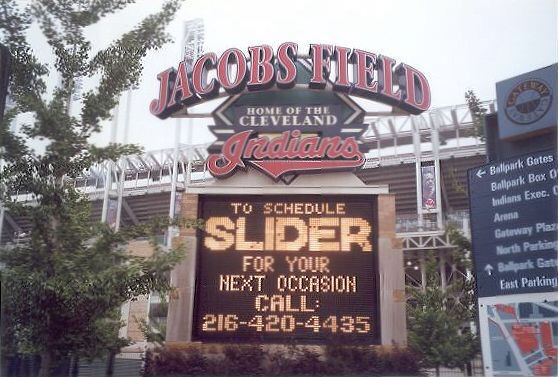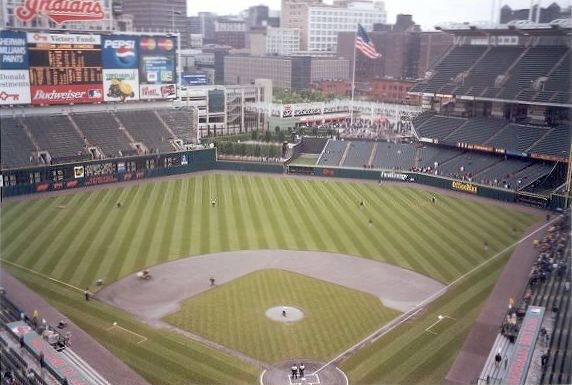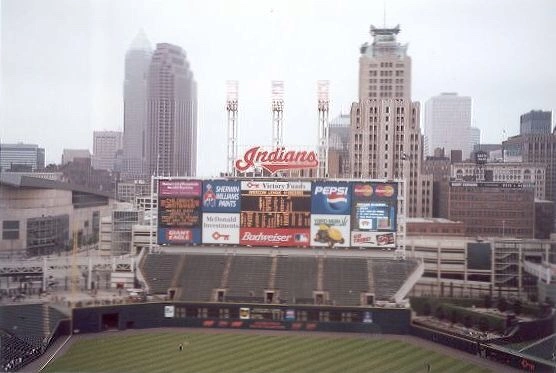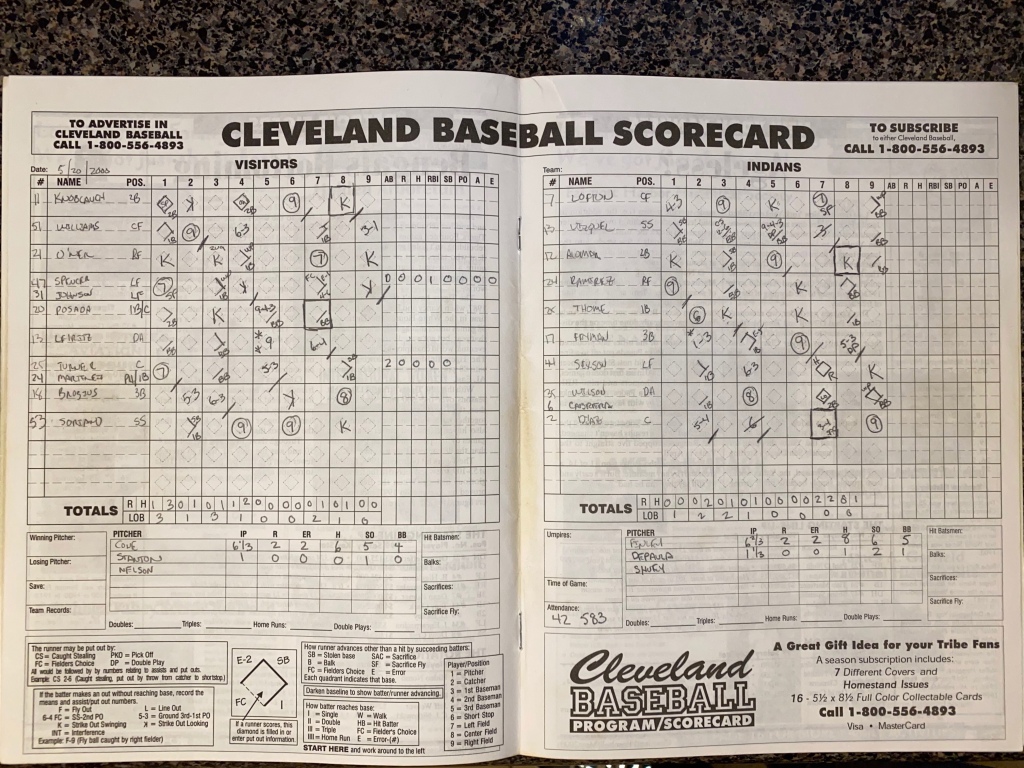
- First visit: Wednesday September 19th 2001
- Most recent visit: Sunday September 17 2006
Our first visit to PNC Park was not supposed to happen. This game was originally scheduled to be played at Shea Stadium in New York City, but following the attacks on September 11th 2001, the parking lot at Shea was used as a staging area to deal with the aftermath of the attacks. Since Shea Stadium would not be available for baseball in the near term, the games were moved to PNC Park in Pittsburgh PA. After a short break, baseball resumed on September 17th 2001, and the Mets played a three game set against the Pirates, starting on that date.
Since we had travel plans scrapped after the attacks (we were flying to Chicago to see the Pirates take on the Cubs, but the games and flights were cancelled), we both had some time off. We chose to attend the last game of the series, a Wednesday matinee on September 19th. Getting an early start from central NJ, we made the 365 mile drive in about five and one-half hours, arriving at the ballpark before noon. Because the game was supposed to be played in New York, there was not much demand for parking, which allowed us to park just across the street from the stadium for a reasonable price.

With time before the game, we briefly wandered around the park. Along the right field wall, we discovered a walking path adjacent to the Allegheny River. Dubbed Three Rivers Heritage Trail, the concrete path snakes along the river for about one and one-half miles. Given our time constraints, we did not amble nearly that far, but we did enjoy the view of downtown Pittsburgh from the riverside. Even if we were not taking in a ballgame that day, a simple trek along the river would have provided an early afternoon of peaceful vistas. Its proximity to the river enhanced the appeal of PNC Park, and we had not even seen the inside of the stadium yet!
During our exploration of the environs of the the stadium, we found a pair of Pirates greats immortalized in bronze. Both Roberto Clemente and Willie Stargell were on display outside the park, with each statue larger than life. Roberto Clemente was just a bit before my time, as I was a toddler when he had his best years in Pittsburgh. Conversely, I was much more familiar with Stargell, with his trademark “windmill” bat twirl just before the arrival of the pitch. Two other statutes stood outside the ballpark (Honus Wagner and Bill Mazeroski) eluded our search, but perhaps we would view them on another visit.

PNC Park is a baseball only stadium, at the end of its inaugural season in September 2001. Since the game was not supposed to be played in PNC Park, there were few fans present was we ended our tour of the outside of the stadium before heading into the park. It seemed that, based on the number of New York jerseys we saw on people milling around near the home plate entrance, those who did attend the matinee were mainly Mets fans, making a drive similar to ours. Apparently a five hour drive did not deter the New York faithful, who seemed determined to see the game. Unfortunately, the weather was less than cooperative, with warm and humid conditions under mainly cloudy skies.
Once inside, we could immediately see that the view of downtown Pittsburgh was the focus of the new ballpark. Unlike its predecessor (Three Rivers Stadium), PNC Park was open in centerfield, providing a sweeping vista of the city and Allegheny in front of it. Rather than AstroTurf, the field was covered with Kentucky bluegrass, which looked a bit worse for wear after a hot Pittsburgh summer. As we started to walk along the lower concourse toward right field, I couldn’t tear myself away from the view beyond the centerfield wall! Beyond the ballpark, several of the bridges connecting the north shore of the Allegheny River to downtown Pittsburgh were painted Aztec gold. At the time, I did not understand why they were painted this hue, but research later indicated that the bridges connected surrounding areas to the Golden Triangle section of the city. In any case, even the overcast of the day could not hide the luster of the bridges, and I discovered that I’d found my new favorite MLB ballpark!

Following the lower concourse to the right field line brought us to the detached bleacher area, which extends from the foul pole to the 375 foot sign in right centerfield (where a hand operated scoreboard runs the length of the 21 foot high fence). Venturing up into the bleachers gave us a great view of the river and the city. Each seat provided a clean view of the action, due primarily to the elevated nature of the bleachers. Continuing counter clockwise on the lower concourse, we encountered a smaller bleacher area adjacent to the green batter’s eye in centerfield. Since the crowd was small, there were very few fans here, but given the sight lines here (as all seats in PNC Park are angled to produce the best view of home plate), these seats appear as though they would be almost as good as the seats in the right field bleachers.
Standing on the lower concourse behind the batter’s eye gave us an amazing view of the bridges and downtown Pittsburgh. Even the pictures we took on the cloudy and humid day (resulting in haze that partially obscured the city) could not do justice to the backdrop for PNC Park. Even if we did not see a game here, the view alone was worth the time and expense. Proceeding toward home plate, we got a close up view of the video board, which stood atop two tiered seating in left field. The video board seemed curiously small for a brand new park, which is not necessarily a bad thing. Light stands bracketing the video board were wrought steel, and looked similar those at Comerica Park. In fact, the placement and size of the video board at Comerica Park bore a striking resemblance to what we saw at PNC Park.

We completed the loop around the stadium on the lower concourse behind home plate, and went in search of a baseball lunch. Like most “newer” MLB stadiums, PNC Park has many places to eat, including outlets of many popular local restaurants, with premium services available in the club level provided by Levy’s Restaurant. Per my usual, I eschewed these choices, instead choosing hot dogs and drinks to bring to our seats. In keeping with the somber nature of the situation following the attacks on 9/11, there was a sense of sullenness in the crowd, and even the typically boisterous Mets fans kept their enthusiasm in check for the game. Mets players were wearing hats of the various first responder services (like the NYPD, NYFD, etc.) that gallantly answered the call during and after the attacks.

Despite the air of melancholy in the air at PNC Park that afternoon, Mets players did sign autographs and interact with the crowd. Because the game was moved to Pittsburgh with little advance notice, we were able to get seats along the right field line just beyond the Mets dugout (PNC Park is one of the few MLB parks where the home team dugout is on the third base side). Though I was mesmerized by the ballpark and its surroundings, we were there to see a game. Following a World Series berth in 2000, New York, facing a depleted Pirates squad, overcame an early deficit to win the game, 9-2. We were treated to a Mike Piazza home run, and the game time was under three hours. Facing a long drive home, we headed straight to the parking lot. PNC Park was as advertised and much more, leaving me dazzled. We would have to return, if only to the the park and its views in better weather conditions.

Our second visit to PNC Park was not as hurried, as we planned a weekend visit to Pittsburgh to once again see the New York Mets. Unlike our previous stay, clear skies and pleasantly warm and dry conditions were expected for Saturday and Sunday. Our trip from central NJ to Pittsburgh was uneventful, and we drop off our bags at the hotel before heading to the park. Leaving ourselves plenty of time to explore, we crossed the Allegheny River on one of the bridges, where my brother got some excellent shots of the stadium, with the river in the foreground. Given the great late summer weather, we strolled along the riverfront, where we encountered scores of people walking, biking and sitting along the banks of the river.

Following our extended tour of the area, we headed into PNC Park through the home plate entrance. Of course, we wandered through the ballpark, though we didn’t spend as much time doing so, as we would get a better look at the park the next afternoon. After visiting the concession stand in the lower level behind home plate for a baseball dinner, we headed to our seats. Because the Pirates were playing out a disappointing season, tickets for the game were plentiful, and we were fortunate enough to secure good seats just to the right of home plate in the lower level.
Sunshine, though decreasing with time, afforded us a better look at PNC Park and downtown Pittsburgh. The Aztec gold of the bridges crossing the Allegheny seemed more vivid in the waning daylight, and the overall feel of the park was much lighter, a stark contrast to our previous visit, when skies were gray and the country was still reeling from the attacks on 9/11. PNC Park has a two tiered seating area extending from the left field foul pole behind home plate to the right field foul pole (minus the luxury boxes and the press level). When combined with the bleachers, there were just over 38,000 seats in the ballpark (which is the second smallest capacity in MLB), and almost all of the seats in the stadium offer a view of downtown Pittsburgh.

PNC Park offers one of the smallest distances from home plate to the backstop (51 feet), giving fans nearly unprecedented closeness to the action. Clearly, the stadium was designed with a maximum fan experience in mind. When combined with the spectacular views of the city and the river, my opinion that PNC Park was the best park in MLB (though my brother would disagree, as he is partial to Comerica Park) was cemented. Even after the game started, I found myself scoping out the park and scenery beyond it, instead of paying more attention to the action on the field. More than once, I found myself envious of the Pirates home, wishing and hoping that the Mets would construct a ballpark with similar magic.

Though 25 games under .500 coming into the game, the Pirates kept pace with the visiting Mets (who were destined for a division championship and a trip to the 2006 NLCS), as evening blended into night. Surprisingly, there were few lights emanating from the buildings in downtown Pittsburgh, as I expected the coming of night might allow the downtown area to shine. That was probably the only negative we encountered on our visit to the park that evening. Had the game been a nationally televised broadcast, it is possible that the city might have obliged with more lights from the structures, producing a spectacle for the fans in attendance and those on TV.
Between the time we entered the ballpark before the game and the third inning, the crowd filled out nicely. Even the four level steel rotunda in left field, used primarily for standing room only, was filled with fans. Officially, there were more than 37,000 people in the ballpark that night (nearly a sellout), but the actual count was almost certainly less. In any event, the fans in attendance made their presence felt, and the game was deadlocked at two going into the bottom of the ninth. Pittsburgh scratched out a run in the bottom of the frame, beating the Mets and their closer, Aaron Heilman 3-2. As the jubilant Pirate fans filed out of PNC Park that night, I quickly scanned the ballpark while we waited to exit. As we left, I remember thinking that I hoped the Pittsburgh fans appreciated the park they were lucky enough to call home.

Sunday September 17 2006 was a mainly sunny and pleasantly warm late summer day, and after breakfast we headed out to PNC Park to see the finale of the series. Early morning fog was begin transformed into cumulus clouds as the sun shone over the park, and the filtered sunshine showed that we were indeed headed toward fall, despite the warm weather. We did not spend as much time outside of the park as the previous day, but we did focus our attention on the river. Much like we saw in Cincinnati in 2004, there was quite a bit of river boat traffic this Sunday morning, and it reminded me what life might have been like on the river long ago. Leftover haze gave the river and its surroundings a softer hue, and somehow this seemed to add to the appeal of the area.

Upon entering the park, we conducted one final walkthrough of the stadium with the best conditions we had seen so far. Based on the number of fans milling around outside, the crowd promised to be much smaller than the game the previous night. Our experience has taught that Sunday afternoon games were usually more lightly attended than Saturday night games, and it seemed that trend would hold for the afternoon contest. In addition, we had entered football season, which meant the part of the crowd that might have come to see a poorly performing Pirate team instead stayed home to watch gridiron action. Regardless of the reason, we expected to have more elbow room for the matinee contest.
Before getting a baseball lunch and heading for our seats, we headed up the upper deck to get some pictures of the stadium with downtown as the backdrop. From that vantage point, my brother took some of my favorite ballpark pictures, and even those picture did not do the scenery justice. Though we did not have pristine conditions, the panorama my brother constructed from those pictures qualify (in my opinion; his may vary) as his best work at baseball stadiums, and helps to shape my opinion of PNC Park being the best ballpark in MLB.

Our seats were very similar to those of the previous night, in the lower level just to the right of home plate. For the New York Mets, the game was not particularly meaningful, as they were on their way to the NL East title, but most of the regular starters were in the lineup. On the mound for the Mets was right hander John Maine, who was the number five starter in the New York rotation. For the hometown Pirates, left hander Zach Duke took the mound. Duke was the ace of the Pittsburgh staff, and we were not quite sure what to expect out of either team, with so little at stake for either team this late in the season.
Pittsburgh scored two runs against the Mets in the bottom of the first inning, and as it would turn out, that would be more than enough for Duke, who tossed eight shutout innings against a formidable New York lineup. Despite the second straight flat performance by the Mets, the game was again almost superfluous, as the fine late summer conditions made PNC Park shine even more than the night before. In between innings, I spent my time shifting my attention from one feature to the other, while my brother’s camera was busy capturing the nearly perfect baseball environment. As we suspected, the crowd was quite thin, nowhere near the announced crowd of nearly 30,00. Later I would learn that the Pirates’ attendance in 2006 was 1.8 million, which was next to last in the NL. Apparently, a poorly playing team trumped the beautiful ballpark, which had been racking up accolades since it opened its doors in 2001.

Time passed quickly during the low scoring game, which clocked in at about two hours and 30 minutes, which was shorter than the league average. Before I knew it, we were leaving this baseball palace, headed out for a five hour drive back home to central NJ (during which we would listen to the Jets lose another game). To say we thoroughly enjoyed the ballpark would be a great understatement. Though we were split as to whether we thought that PNC Park was the best MLB park, we did agree that it was a great baseball experience that we would have to repeat as soon as possible. If you find yourself near Pittsburgh during baseball season, check to see if the Pirates are home. If they are, GO! You will be glad that you did.






